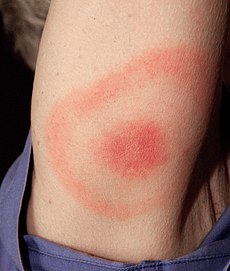Drug Induced Vasculitis
Vasculitis is inflammation of blood vessels that can cause their
complete occlusion or lead to leakage of blood components through the vessel
wall.
The inflammation can affect any of the vessels in the skin
including capillaries, venules, arterioles and lymphatics.
The chief drugs involved in causing vasculitis are as
follows:
Thiazide diuretics
Thiouracil
Antibiotics
Nonsteroidal anti-inflammatory drugs (NSAIDs)
Oral anticoagulants ( warfarin and coumarin).
 skin vasculitis
skin vasculitis
Mechanism of Drug Induced Vasculitis :
Both cell mediated
and humoral immunity are thought to play a role.
The most common encountered skin rash is non blanching purpura
on the limbs.
Treatment involves:
Withdrawing the offending drug
Administration of systemic steroids
Erythema Multiforme:
Erythema multiforme (EM) is an acute, self-limited, and
sometimes recurring skin condition that is considered to be a type IV
hypersensitivity reaction associated with certain infections, medications, and
other various triggers
The characterstic rash is called as target lesions that involve elbows,face and
palms.
These lesions have a central vesicle and are erythematous.
There may or may not be some systemic features associated
with this rash
 Erythema multiforme
Erythema multiforme
Precipitating factors include
Herpes simplex virus (HSV)
Epstein-Barr virus (EBV)
Histoplasmosis
Mycoplasma
Erythema multiforme represents mild end of spectrum of skin
conditons with Steven Johnson”s syndrome the severest.
Following is a list of medications that cause Erythema multiforme:
Barbiturates
Non-steroidal anti-inflammatory drugs
Penicillins
Sulphonamides
Phenothiazines
Anticonvulsants.
Diagnosis
This is usually clinical but in case of doubt,skin biopsy is
diagnostic that show on histology necrotic
keratinocytes,lymphocytic infiltrate
and blister formation
Management:
This is usually achieved by stopping the causative
medication and applications of topical steroids
Erythema Multiforme major may require hospital admission for
supportive care
Oral antihistamines and/or topical corticosteroids may help
relieve itching.
Following treatments t have been reported to help suppress
recurrent Erythema Multiforme:
Antimalarial drugs eg hydroxychloroquine
Dapsone 100-150mg/d
Azathioprine 100-150 mg/d
Miscellaneous Drugs in Resistant cases:
Ciclosporin,
Mycophenolate mofetil
Photochemotherapy (PUVA)
Thalidomide
No comments:
Post a Comment